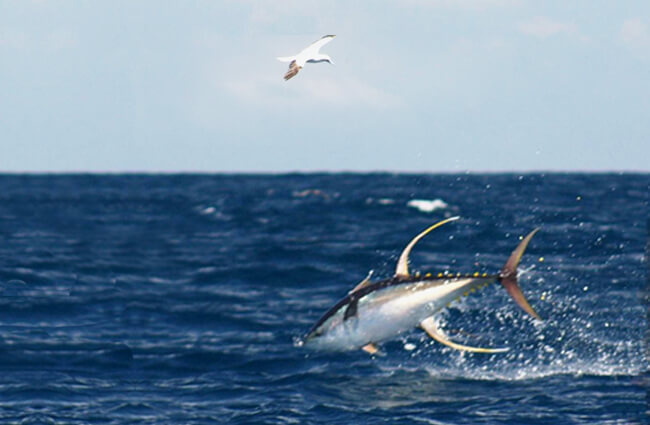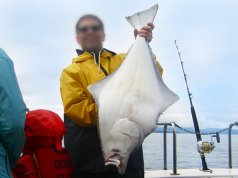The Ocean’s Golden Torpedo: Unveiling the Yellowfin Tuna
Imagine a creature built for pure speed, a shimmering torpedo of muscle and grace that navigates the vast blue with unparalleled agility. This is the Yellowfin Tuna, a true marvel of marine engineering and one of the ocean’s most iconic inhabitants. From its distinctive golden fins to its incredible migratory journeys, this powerful fish captures the imagination of scientists, anglers, and seafood enthusiasts alike. Join us on a deep dive into the world of Thunnus albacares, exploring its life, its role in the ecosystem, and its complex relationship with humanity.

Meet the Yellowfin: Basic Biology and Identification
The Yellowfin Tuna is a member of the Scombridae family, which includes mackerels and other tunas. It is instantly recognizable by several key features that make it stand out in the marine world.
Physical Characteristics
Yellowfin Tuna possess a sleek, fusiform body, perfectly designed for cutting through water at high speeds. Their backs are a metallic dark blue or black, fading to silver on the belly, often with a broken line of vertical white stripes. The most striking features, and the source of their common name, are the bright yellow finlets running down the back and belly, as well as the prominent yellow second dorsal and anal fins, which can be quite long in larger specimens. Adults can reach impressive sizes, commonly growing up to 1.8 meters (6 feet) in length and weighing over 180 kilograms (400 pounds), though some exceptional individuals have exceeded these measurements. Their powerful, crescent-shaped tail propels them through the water, allowing bursts of speed that can reach up to 80 kilometers per hour (50 miles per hour).
Where They Call Home: Habitat and Distribution
Yellowfin Tuna are truly creatures of the open ocean, preferring the warm, tropical and subtropical waters of the Atlantic, Pacific, and Indian Oceans. They are a pelagic species, meaning they live in the open sea, far from coastal areas. These magnificent fish typically inhabit the upper layers of the water column, generally staying within the top 100 meters (330 feet), though they are capable of diving to depths of several hundred meters in search of prey or to regulate their body temperature. For an animal lover hoping to observe Yellowfin Tuna in their natural habitat, the best approach involves venturing into these vast oceanic regions, often through specialized fishing charters or scientific expeditions. They are frequently found near oceanic islands, seamounts, and areas where upwellings bring nutrient-rich waters to the surface, attracting their prey. Look for signs of feeding activity, such as diving seabirds or schools of baitfish, which often indicate the presence of Yellowfin Tuna below.

A Life in the Blue: Ecology and Behavior
The life of a Yellowfin Tuna is one of constant motion, driven by the need to feed, reproduce, and navigate the complex dynamics of the open ocean.
The Yellowfin’s Menu: Diet and Feeding Habits
As apex predators, Yellowfin Tuna play a crucial role in their marine ecosystems. Their diet is diverse and opportunistic, reflecting the abundance of food sources in the open ocean. They primarily feed on other fish, such as flying fish, mackerel, and sardines, but also consume crustaceans, like crabs and shrimp, and cephalopods, including squid and octopus. Yellowfin Tuna are highly visual hunters, often forming large schools to cooperatively herd and ambush their prey. These feeding frenzies can be spectacular events, with tuna leaping out of the water in pursuit of their next meal. Their exceptional speed and powerful jaws make them incredibly efficient predators.
From Egg to Adult: Mating and Reproduction
Reproduction in Yellowfin Tuna is a fascinating process tied closely to the warm waters they inhabit. Spawning typically occurs in tropical and subtropical regions throughout the year, with peak activity in specific seasons depending on the ocean basin. They are broadcast spawners, meaning females release millions of tiny eggs into the water column, which are then externally fertilized by males. A single large female can produce several million eggs per spawning event, and they may spawn multiple times within a season. The eggs are pelagic, drifting with the currents until they hatch, usually within 24 to 48 hours. Yellowfin Tuna larvae are tiny and vulnerable, but they grow rapidly. They reach sexual maturity relatively quickly, often within two to three years, allowing for a robust reproductive output. This rapid growth and early maturity are key to their success as a widespread species.

The Ocean’s Architects: Ecosystem Role
As top predators, Yellowfin Tuna exert significant control over the populations of their prey species, helping to maintain the balance of marine food webs. Their presence indicates a healthy and productive pelagic ecosystem. They interact with a wide array of other marine animals. While they prey on smaller fish and invertebrates, they themselves are prey for even larger predators, particularly oceanic sharks and marine mammals like orcas, especially when they are young. Their schooling behavior also creates temporary habitats and feeding opportunities for other species, such as seabirds and dolphins, which often associate with tuna schools to capitalize on the concentrated prey.
Yellowfin Through Time: Evolutionary Journey
The evolutionary history of tunas, including the Yellowfin, is a testament to the power of natural selection in shaping highly specialized marine predators. Tunas belong to a group of highly evolved bony fish that have adapted remarkably to a fast-paced, open-ocean existence. Their streamlined bodies, powerful musculature, and unique physiological adaptations, such as regional endothermy (the ability to maintain a body temperature warmer than the surrounding water in certain parts of their body), are products of millions of years of evolution. This warm-bloodedness allows them to operate at peak performance in colder waters and gives them an advantage in hunting fast-moving prey. The Yellowfin’s lineage can be traced back to ancient scombrid ancestors, gradually evolving the characteristics that make it such an efficient and dominant force in today’s oceans.

Yellowfin and Humanity: A Complex Relationship
The Yellowfin Tuna holds a significant place in human culture and economy, leading to both appreciation and challenges.
A Culinary Star: Contribution to Human Culture
Globally, Yellowfin Tuna is one of the most commercially important fish species. Its firm, flavorful flesh is highly prized, particularly in Japanese cuisine where it is a staple for sushi and sashimi. Beyond fine dining, it is also a popular choice for grilling, searing, and canning, making it accessible to a wide range of consumers. The economic value of Yellowfin Tuna supports countless livelihoods, from fishermen and processing plant workers to restaurateurs and retailers around the world. Its presence on menus and in markets reflects its deep integration into human culinary traditions and global food systems.
The Human Connection: Interaction and Conservation
Human interaction with Yellowfin Tuna is primarily through fishing. Commercial fisheries target Yellowfin using various methods, including purse seines, longlines, and pole-and-line fishing. Recreational anglers also highly value Yellowfin for its fighting prowess, making it a sought-after game fish. However, this intense interest has led to concerns about overfishing and the sustainability of Yellowfin populations. Bycatch, the unintentional capture of non-target species, is another significant issue, particularly with certain commercial fishing methods. Conservation efforts are crucial and involve international agreements, fishing quotas, and the promotion of sustainable fishing practices. Consumers can contribute by choosing Yellowfin Tuna sourced from well-managed fisheries. For those who encounter Yellowfin Tuna in the wild, particularly anglers, responsible practices include adhering to catch limits, using appropriate gear, and considering catch-and-release to support healthy populations. It is important to note that a “hiker” would not typically encounter a live Yellowfin Tuna in its natural habitat, as these are open ocean fish. If one were to encounter a stranded marine animal on a beach, the best course of action is to contact local marine wildlife authorities or rescue organizations, rather than attempting to intervene directly, as these animals can be large and require specialized care.
![Yellowfin Tuna during a longline fishing research Photo by: Allen Shimada, NOAA NMFS OST [Public domain]](https://animals.net/wp-content/uploads/2020/02/Yellowfin-Tuna-6-650x425.jpg)
Fascinating Facts About Yellowfin Tuna
- Incredible Speed: Yellowfin Tuna are among the fastest fish in the ocean, capable of reaching speeds up to 80 km/h (50 mph) in short bursts.
- Deep Divers: While often found in surface waters, they can dive to depths of over 1,000 meters (3,300 feet) to hunt.
- Warm-Blooded Wonders: Like other tunas, Yellowfin exhibit regional endothermy, allowing them to maintain warmer body temperatures in their core muscles and brain, enhancing their hunting efficiency.
- Long Migrations: They undertake extensive migrations across ocean basins, traveling thousands of kilometers in search of food and spawning grounds.
- Social Creatures: Yellowfin Tuna often school with other tuna species, as well as dolphins and whales, a behavior thought to aid in hunting and protection.
- Relatively Short Lifespan: Despite their large size, Yellowfin Tuna typically live for about 6 to 7 years, though some individuals can reach up to 9 years.
- “Ahi” in Hawaii: In Hawaii, Yellowfin Tuna is commonly known as “Ahi,” a term also used for Bigeye Tuna.
Caring for Yellowfin: Insights for Aspiring Zoologists and Zookeepers
Understanding and caring for Yellowfin Tuna presents unique challenges and opportunities for marine science professionals.
For the Aspiring Zoologist
Studying Yellowfin Tuna offers a dynamic field for aspiring zoologists. Research areas include population dynamics, migration patterns using tagging technology, reproductive biology, feeding ecology, and the impacts of climate change and fishing pressure. The sheer scale of their habitat and their migratory nature make them challenging subjects, often requiring international collaboration and advanced oceanographic tools. Understanding their physiology, particularly their endothermy, provides insights into evolutionary adaptations for life in the open ocean. A strong foundation in marine biology, fisheries science, and oceanography is essential for those wishing to contribute to our knowledge of these magnificent fish.
Yellowfin in Captivity: A Zookeeper’s Guide
Keeping Yellowfin Tuna in captivity is an extremely demanding task, typically only undertaken by large, specialized public aquariums due to their size, speed, and pelagic nature. The primary tasks for a zookeeper would involve:
- Providing an Enormous Habitat: Yellowfin require vast, circular tanks to accommodate their continuous swimming and prevent collisions. Tanks must be hundreds of thousands, if not millions, of liters in volume.
- Maintaining Pristine Water Quality: Strict control over temperature, salinity, oxygen levels, and filtration is paramount to mimic their natural oceanic environment.
- Specialized Diet: A varied diet of high-quality, appropriately sized fish and squid, often supplemented with vitamins, is necessary to meet their high metabolic demands. Feeding schedules must be consistent.
- Monitoring Health and Behavior: Regular observation for signs of stress, injury, or disease is critical. This includes monitoring swimming patterns, feeding responses, and physical condition.
- Social Structure: Tunas are schooling fish, so keeping them in appropriate groups can reduce stress, but tank size limits the number of individuals.
What should be avoided:
- Small or Rectangular Tanks: These are entirely unsuitable and will lead to stress, injury, and death due to their constant need to swim and inability to navigate corners.
- Poor Water Parameters: Fluctuations in water quality or incorrect parameters will quickly compromise their health.
- Inadequate Diet: Insufficient quantity or quality of food will lead to malnutrition and health issues.
- Sudden Changes: Tunas are sensitive to sudden changes in their environment, including lighting, water flow, or tank mates.
- Overcrowding: Too many individuals in a tank, even a large one, can lead to aggression and stress.

Conclusion: Guardians of the Golden Fins
The Yellowfin Tuna stands as a testament to the incredible diversity and power of marine life. From its lightning-fast sprints across ocean expanses to its vital role in the marine food web, this golden-finned marvel is a species of immense ecological and economic importance. As our understanding of Yellowfin Tuna deepens, so too does our responsibility to ensure its future. Through continued research, sustainable practices, and a collective commitment to ocean health, we can all contribute to safeguarding these magnificent creatures for generations to come, ensuring the ocean’s golden torpedoes continue to thrive in their vast blue home.

![Red Angus Closeup of a beautiful Red Angus cowPhoto by: U.S. Department of Agriculture [pubic domain]https://creativecommons.org/licenses/by/2.0/](https://animals.net/wp-content/uploads/2020/03/Red-Angus-4-238x178.jpg)




![Red Angus Closeup of a beautiful Red Angus cowPhoto by: U.S. Department of Agriculture [pubic domain]https://creativecommons.org/licenses/by/2.0/](https://animals.net/wp-content/uploads/2020/03/Red-Angus-4-100x75.jpg)

